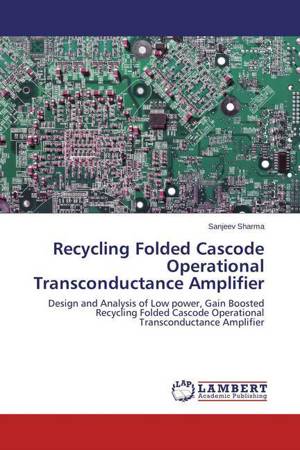
Je cadeautjes zeker op tijd in huis hebben voor de feestdagen? Kom langs in onze winkels en vind het perfecte geschenk!
- Afhalen na 1 uur in een winkel met voorraad
- Gratis thuislevering in België vanaf € 30
- Ruim aanbod met 7 miljoen producten
Je cadeautjes zeker op tijd in huis hebben voor de feestdagen? Kom langs in onze winkels en vind het perfecte geschenk!
- Afhalen na 1 uur in een winkel met voorraad
- Gratis thuislevering in België vanaf € 30
- Ruim aanbod met 7 miljoen producten
Zoeken
Recycling Folded Cascode Operational Transconductance Amplifier
Design and Analysis of Low power, Gain Boosted Recycling Folded Cascode Operational Transconductance Amplifier
Sanjeev Sharma
Paperback | Engels
€ 47,95
+ 95 punten
Omschrijving
In this work the low power Gain Boosted Recycling Folded Cascode Operational Transconductance Amplifier (GB-RFC OTA) is designed and analyzed using 130nm CMOS technology. The design of the circuit is made schematically using design entry tool. Tanner Schematic Editor(S-Edit) is used for design entry. The generated net-list is simulated using T-Spice .For functional verification of the OTA circuits;DC, AC, transient analysis have been carried out. The proposed design is based on Recycling Folded Cascode topology.The recycling folded cascode OTA increases the effective transconductance of FC-OTA which further enhance the other performance parameters such as Gain, GBW and speed of amplifier within same area and power budget.The additional cascode Gain stage is used to increase the gain of the design by enhancing its output impedance. The different compensation techniques are discussed and Single Miller Capacitor Nulling Resistor is used as compensation circuitry in order to achieve the significant Phase Margin. The small compensation capacitor (Cc) of 3pf is used, which also improves the slew rate.The proposed design operates on 1V Power supply and consumes a power of 700µW.
Specificaties
Betrokkenen
- Auteur(s):
- Uitgeverij:
Inhoud
- Aantal bladzijden:
- 84
- Taal:
- Engels
Eigenschappen
- Productcode (EAN):
- 9783659575686
- Verschijningsdatum:
- 22/07/2014
- Uitvoering:
- Paperback
- Afmetingen:
- 150 mm x 220 mm
- Gewicht:
- 136 g

Alleen bij Standaard Boekhandel
+ 95 punten op je klantenkaart van Standaard Boekhandel
Beoordelingen
We publiceren alleen reviews die voldoen aan de voorwaarden voor reviews. Bekijk onze voorwaarden voor reviews.









